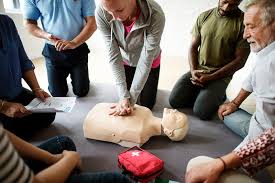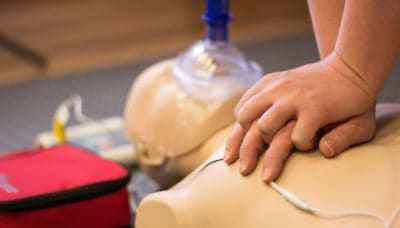Introduction
Cardiopulmonary resuscitation (MOUTH-TO-MOUTH RESUSCITATION) is a lifesaving method that everybody must know. Nonetheless, regardless of its critical significance, numerous false impressions surround mouth-to-mouth resuscitation techniques and accreditation. Lots of individuals might be reluctant to get accredited because of these misunderstandings, which can eventually set you back lives in emergency situation circumstances. This write-up aims to unmask widespread myths concerning CPR while stressing the importance of obtaining licensed through recognized first help courses By comprehending the facts, you can empower yourself and potentially save a life.
Common Misconceptions About mouth-to-mouth resuscitation and Why You Ought To Get Certified
What Is CPR? Understanding the Basics
CPR means cardiopulmonary resuscitation, a procedure developed to restore breathing and blood circulation in an individual who has actually stopped taking a breath or whose heart has stopped beating. The strategy involves chest compressions combined with artificial ventilation strategies such as mouth-to-mouth breathing or utilizing a bag-mask device.
- Key Components of mouth-to-mouth resuscitation: Chest Compressions: These help preserve blood circulation to important organs. Rescue Breaths: These supply oxygen to the lungs. Automated Exterior Defibrillator (AED): A gadget that can surprise the heart back into rhythm in situation of specific cardiac arrests.
Misconception 1: Just Medical Professionals Can Do CPR
One typical myth is that just experienced physician can carry out mouth-to-mouth resuscitation efficiently. While doctor are certainly skilled at it, anybody can learn how to CPR Course Mackay - skillstrainingcollege.com.au carry out mouth-to-mouth resuscitation with CPR courses

- The Reality: Laypersons can be educated to carry out reliable CPR. Basic methods are straightforward and can be understood by anyone going to learn. Bystanders typically play vital duties in conserving lives before professional assistance arrives.
Misconception 2: mouth-to-mouth resuscitation Is Only Useful for Cardiac Arrest Victims
Another widespread misunderstanding is that mouth-to-mouth resuscitation is exclusively for individuals experiencing cardiac arrest. Actually, CPR can be beneficial in different emergencies.
- Other Scenarios Where mouth-to-mouth resuscitation Serves: Drowning incidents Drug overdoses Choking targets where the respiratory tract has been compromised
Misconception 3: You Need To Prevent Giving Rescue Breaths
Many people think rescue breaths are unnecessary or even dangerous due to the danger of infection or other problems. This originates from complication concerning exactly how COVID-19 may impact these practices.
- The Realities: Rescue breaths are essential for offering oxygen. During circumstances like drowning or opioid overdose, rescue breaths become crucial. Hands-only mouth-to-mouth resuscitation is suggested when someone is untrained or hesitant but knowing both methods remains vital.
Misconception 4: You Can't Harm Somebody by Performing Mouth-to-mouth Resuscitation Incorrectly
While it's true that performing CPR incorrectly might cause some damage, not trying it in any way may lead to death.
- Understanding the Risks: Rib cracks might happen throughout hostile chest compressions. Any activity taken is much better than doing nothing; modern-day guidelines highlight that "something" is much better than "absolutely nothing" during heart attack situations.
Misconception 5: When You're Trained, You Don't Need Further Training
Some individuals believe that once they have actually finished a training course, they do not need additional training or recertification.
- Why Continuous Training Issues: Techniques evolve gradually based upon brand-new research. Regular refresher courses maintain your abilities sharp and ensure you're up-to-date with present best practices.
Misconception 6: Children Don't Required CPR Training
Parents usually presume they won't need to execute CPR on their children since youngsters do not experience heart occasions as frequently as adults do.

- The Fact for Parents: Children can experience respiratory system concerns, choking events, or drowning situations requiring immediate attention. Learning pediatric-specific strategies makes sure preparedness throughout emergency situations involving children.
Importance of Getting Licensed in Emergency Treatment and Mouth-to-mouth Resuscitation Courses
Why Certification Issues in Emergency Situation Situations
Being accredited in first aid and CPR provides several advantages past just discovering life-saving skills:

- Enhances confidence when encountering emergencies Increases recognition of safety and security protocols Encourages more individuals to advance in emergency situation circumstances
Benefits of Taking an Emergency Treatment Course
Comprehensive Skill Set: Individuals learn not nearly CPR however additionally standard emergency treatment concepts such as wound care and managing fractures. Legal Security: Qualification typically features Do-gooder regulations security when helping a person during an emergency. Career Opportunities: Numerous jobs call for emergency treatment certification as part of their safety and security procedures; being certified boosts employability in areas like teaching, training, health care, and childcare.FAQs About Typical Misconceptions Pertaining To CPR
FAQ 1: What kind of training do I need for reliable CPR?
You needs to enlist in acknowledged CPR courses that cover both adult and child resuscitation techniques effectively.
FAQ 2: Just how often need to I renew my first aid certificate?
It's suggested to restore your first help certificate every two years because standards transform regularly based upon emerging research.
FAQ 3: Is hands-only compression better than traditional CPR?
For untrained onlookers or those awkward providing rescue breaths, hands-only compression is effective however recognizing both methods supplies a higher chance of survival if educated properly.
FAQ 4: What resources are offered for learning more about initial aid?
Numerous companies provide on-line sources along with physical courses; respectable platforms include the American Heart Organization and Red Cross internet sites which information first aid courses available near you.
FAQ 5: Are there any type of age restrictions on taking an emergency treatment course?
Most first help courses welcome participants of any ages; nonetheless, some specialized classes might be tailored toward certain age groups (e.g., youngsters vs grownups).
FAQ 6: Does my workplace require me to get certified?
Certain workplaces-- specifically those including public communication-- commonly call for staff members to have valid certifications in emergency treatment and fundamental life support (BLS).
Conclusion
Understanding the reality behind typical misconceptions concerning mouth-to-mouth resuscitation is critical for raising recognition concerning this life-saving technique. Whether you're a parent wishing to safeguard your kid or a staff member seeking qualification for expert advancement, getting certified via appropriate first aid courses arms you with the expertise required for acting emphatically during emergency situations. Remember-- any individual can discover how to perform effective mouth-to-mouth resuscitation regardless of background; do not allow mistaken beliefs prevent you from ending up being equipped! So why wait? Sign up today for a CPR course!
This extensive overview looks for not just to dispel misconceptions surrounding CPCR but additionally works as an inspiration for every person to seek accreditation so they too can add favorably throughout emergencies!